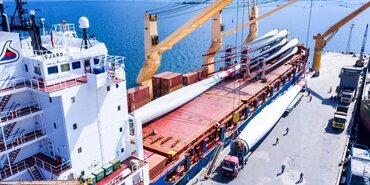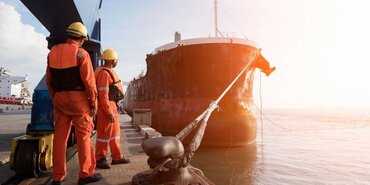TT Talk - Abandoned cargo - more than just money at stake

The risk of abandoned cargo is hardly new; every year the delay or failure of a consignee to collect cargo costs the industry significant time and money. Now it’s costing lives.
Last August, stored ammonium nitrate fertiliser exploded at Beirut port in Lebanon, killed more than 200 people, injured 6,500 and devastated parts of the city. The dangerous stockpile had been neglected at the Beirut port for years. In the aftermath of the deadly blast, port authorities revealed that they had been languishing at the port for more than a decade.
While TT has previously highlighted the risks arising from abandoned cargo impacting freight forwarders, logistic operators and NVOCs, the shocking Beirut revelations highlight the critical need for port authorities and terminal operators to take action.
“the shocking Beirut revelations highlight the critical need for port authorities and terminal operators to take action”
Abandoned cargo is not a new challenge. Every year delivery delay or failure of the consignee to collect cargo results in substantial storage, container demurrage and container detention costs. These issues are also invariably complex and require expensive management time to resolve. There may be no legal or contractual way to escape liability or recover the costs associated with abandoned cargo, including container demurrage, port storage, disposal costs or fines.
As a result, learning how to identify risks early to help mitigate the inevitable fallout is key. Commonly, TT recommends establishing effective due diligence procedures and develop specific processes to identify suspect shipments in order to stay one step ahead. Early detection and proactive management reduces losses. However, in the complex logistics supply chain such things are not always straight-forward; while sales pressures should be managed, relationships with partner operators may dictate tolerating certain bookings where assurances are less present.
The simple lesson is that all bookings should be subject to deliberate business decision-making – and procedures should be crystal clear on how to handle all exceptions. Adequate advance consideration will lead to an informed commercial decision to decline the booking or allocate additional operational attention to the shipment.
Red flags: what to look out for
There are many potential causes of cargo being abandoned at some point in the supply chain – understanding what they are should offer some protection. Most commonly, goods are abandoned at the destination port. Management controls are required to identify problematic commodities, routings and destinations. Other red flags may include uncertainties concerning the nature of the shipper or sanctions issues.
The commodity
Certain commodities present more risk – and may be influenced by geographical or seasonal conditions. Being alert at the outset of the booking process may reduce exposure. Experience will complete your list, but here are a few commodities commonly presenting higher risk:
- Waste (all kinds including fabric, paper and wood)
- Scrap (metals, plastics, wood)
- Cargoes intended for recycling (often waste shipments with an alternate descriptor)
- Used computer equipment
- Used tyres
- Personal effects
While the reasons for uncollected cargo vary, most are relatively low value, high volume and often not newly manufactured goods. However – and particularly arising from cargo integrity concerns – it is important to recognise that declarations may also be fraudulent. Dangerous goods screening checks are equally critical.
Similarly, be alert to the risks presented by counterfeit, non-compliant and prohibited goods. Inevitably, identifying such shipments, and the criminals who are seeking to exploit legitimate transport operations, presents substantial difficulty. It is likely that the goods will not be declared accurately, both as concealment of the illicit trade, and in terms of the nature or potential hazards presented.
The nature of the shipper
Knowing your shipper is fundamental in identifying heightened risks. Not all cases of abandoned cargo involve a shipper who intentionally seeks to deceive, but conducting careful due diligence will pay dividends. The reliability of the shipper is an important consideration in order to assess any heightened risk.
Trade routing
Consider the routing of the cargo being presented for shipment. Deliberately develop knowledge over time in relation to usual trade routes for certain commodities.
Sales contracts & trade fluctuations
The underlying sales contract will not usually be visible to the freight operator, but its terms could point to a reason for abandoned cargo. Be alert to factors that may indicate potential problems, not just where cargo is “shipped to the order of” but also changes in economic or market conditions.
Sanctions issues
A subject familiar to all in the global logistics industry, keeping alert as to the identity of your counterparties and the cargo in question is ever critical.
All this and more is covered in TT’s forthcoming StopLoss and its podcast dedicated to the topic.
Further action required
As with many troublesome issues, the reality is that uncollected shipped goods affects a small fraction of transactions, although it will have disproportionate impact on time, distraction and cost. Whatever the cause – be it mistake, fraud, insolvency or fiscal issues – the lesson of Beirut sadly needs to be learned the world over. TT has been involved in other instances where dangerous goods have languished in terminal areas until their hazards were exposed.
Even amongst sophisticated and well-ordered operations, it has been known that regulated dangerous consignments have simply been ‘lost’ in the system. There is no room for complacency, particularly in geographic areas where extreme seasonal temperatures occur, and therefore ongoing, routine physical checks of the yard remain necessary adjuncts to technologies.
“There is no room for complacency”
Further interactions have demonstrated that emergency planning can be woefully inadequate. Ports and terminals need to have well-considered relationships with local fire and rescue services. This means thinking about access to safety information, considering training and equipment requirements for collaborative emergency response, as well as designating ‘hospital’ areas for distressed cargo. For example, in one instance emergency services forbade access to a container without breathing apparatus, but fire officers did not know how to operate the reach stacker. Clarity on ‘incident control’ required operational information about the cargo, site and equipment.
Simple lesson – leave nothing to assumption; preparation and practice are key.
-
We hope that you have found the above interesting. If you would like further information, or have any comments, please email us, or take this opportunity to forward to any colleagues who you may feel would be interested.
We look forward to hearing from you.
Peregrine Storrs-Fox
Risk Management Director, TT Club
Documents
TT Talk 273 Chinese Translation (651 kB) 06/05/2021
- Author
- Peregrine Storrs-Fox
- Date
- 13/04/2021





